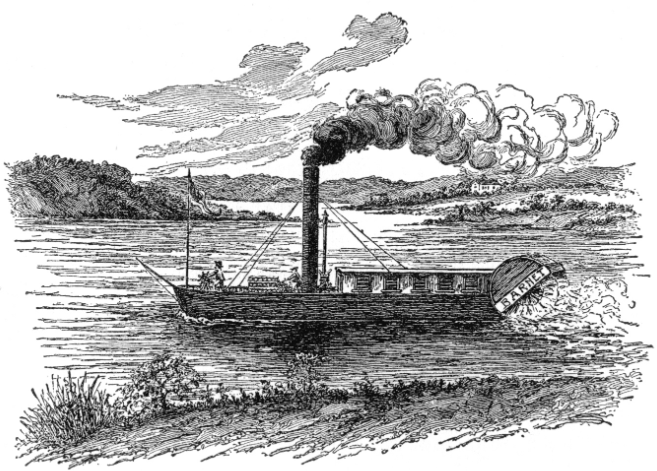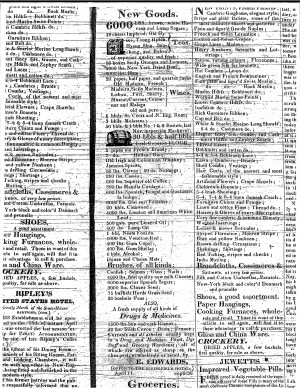Advertisement: West India Goods, May 1827
During the Industrial Revolution Springfield became a center of economic growth, exporting manufactured goods around the world. Advances in technology improved agricultural methods and also contributed to the growth of the factory system.
In the Pioneer Valley, as the importance of farming declined and fewer people were able to produce more food, many people left the countryside to work in new factories. These developments — new opportunities for a growing workforce and technological progress — fueled the development of manufacturing, and dozens of mills and factories transformed themselves in just a few years from trading markets for local farmers to teeming factory towns.
In Springfield, by 1830 eighteen different industries employed more than 600 people. By 1850 a large workforce was producing 20,000 guns a year in the Springfield Armory, and the city also produced swords, footwear, tinware, leather, stoves, and plows.
The Springfield Locomotive Works produced locomotive engines; the American Machine Works produced steam sawmills. New industries emerged: Chicopee built mills that produced cutlery and machinery. Westfield produced whips, cigars, and harness. Holyoke produced paper. In the Florence Village section of Northampton, by the mid-1850s mills were turning out 700,000 yards of cotton cloth each year.
Historians use all kinds of evidence to interpret the past, including old advertisements.
Study the following advertisements to evaluate the changing economies in the Pioneer Valley in the nineteenth century.
Before you look at them, read the "background" narrative. This will help you get the most out of each advertisement and make it easier for you to answer the questions.
AD- WEST INDIA GOODS. SPRINGFIELD REPUBLICAN, 11 MAY, 1827
- What is the name of the business that ran this ad?
- How do we know that the advertiser was a Springfield business?
- What goods could be purchased?
- How could a buyer pay for products?
- What evidence indicates that customers of Bangs and Ely did not always pay their debts promptly?
- Based on the products available for sale, what kind of a store was this?
AD- NEW GOODS. SPRINGFIELD REPUBLICAN, 25 APRIL 1827
- What kind of business ran this advertisement?
- What products originated in the Pioneer Valley?
- What products did the Pioneer Valley import from elsewhere?
- List the countries or regions involved in trading the products included in the ad.
- What conclusions can you draw about the nature of trade at this time?
- What kinds of transportation would the trade in these goods have required?
- What kinds of jobs would have been associated with the trade in these goods?
- Which products were luxuries? Which products were necessities?
- Which items on this list surprise you? Why?
AD- NY AND HARTFORD STEAMBOATS (SPRINGFIELD REPUBLICAN, 17 APRIL 1827)
- Why was steamboat service between New York and Hartford important?
- What conclusions does the regularity of the steamboat service allow you to make?
- What products might have been aboard on the trip downriver to New York?
- What products might have been aboard on the trip upriver to Hartford?
- In what ways did the two steamboats like these contribute to the economies of the Hartford area?
- There is no mention in the advertisement about Sunday steamboat service. Why?
AD-NEW HAVEN TO NORTHAMPTON
- Why is this ad important evidence about the Industrial Revolution in the Pioneer Valley?
- Which part of the journey was probably very slow? For what reasons?
- The transportation methods illustrated here are both a product and a cause of the Industrial Revolution. Explain.
- Each type of transportation created jobs. What are a few examples? What was the relationship between these jobs and economic growth?
- The ad refers to “daily” service, but Sundays are excluded. What explains this?
Both the steamboat Barnet and the railroad were vital to the Industrial Revolution, which launched explosive growth in manufacturing that continued into the twentieth century. Consider a small sample of products made in Springfield from the early nineteenth century to the twentieth.
Examine the images of products manufactured in the Connecticut River Valley. Then answer the questions that follow.
Image List
- Skate blade made in Springfield
- Bemis & Call Hardware: Combination Nut, Pipe, and Adjustable “S” wrench made in Springfield
- Tools
- Absorbine pharmaceutical products from the 1840s to late 19th century
- Checkers and other games
- Books – 4 Hardcover
- Good Housekeeping Magazine, Christmas Issue, 1905
Questions
- What types of industry developed in Springfield?
- What is the relationship between the success of Barnet and Springfield’s role in the Industrial Revolution?
- Do you think any of these goods were produced for only the U.S. market? Europe?
- Based on these ads, was Madison’s American System a success in Springfield? What effect that did improved transportation have on imports to and exports from the Pioneer Valley?
- How did increased trade affect the quality of life for people living in Springfield?
Extension Activity
After you have reviewed the products made in the Valley during the Industrial Revolution, find out if any of them are still produced today. Use the following questions to begin your research.
- What products are manufactured in the Pioneer Valley today?
- What products manufactured in the Pioneer Valley today are similar to the products pictured on this page?
- What factories have been in operation since Barnet’s era?
- What are the main characteristics of industry in the Pioneer Valley today?
As it did during the time of Barnet, the population of the U.S. continues to grow. - Why do so many American companies manufacture their products overseas when there is abundant skilled and unskilled labor here?
- There are far fewer farmers in the Pioneer Valley today than there were in the nineteenth century, even after the Industrial Revolution. To what extent is it a problem? In what ways is agriculture experiencing a rebirth in the Valley?
- Compare the Connecticut River of today with the Connecticut River at the time of Barnet. In what ways is it different?





